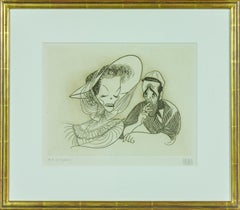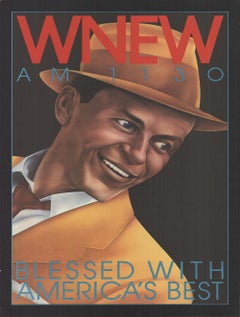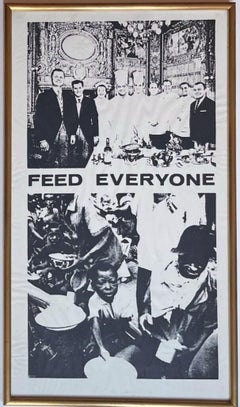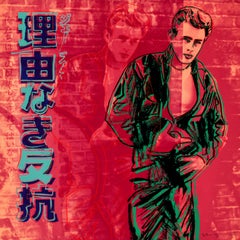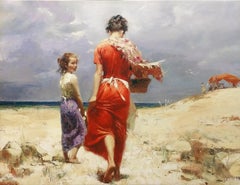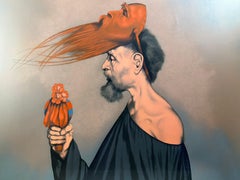People Portrait Prints
to
1,291
2,821
1,118
1,333
706
492
Overall Width
to
Overall Height
to
1,932
1,369
455
280
237
132
122
110
90
81
48
11
8
5
255
103
80
77
75
307
1,307
3,370
1,511
51
109
162
146
171
159
354
658
444
207
249
5,003
1,154
300
6,496
3,581
3,066
2,613
1,935
1,525
1,224
1,140
913
788
733
429
384
376
249
213
200
195
172
169
2,413
1,616
1,162
592
389
932
2,865
3,339
2,148
Art Subject: People
"Hepburn and Bogart" original etching by Al Hirschfeld. Hand signed and numbered
Located in Boca Raton, FL
"Hepburn and Bogart" original etching by Al Hirschfeld. Caricature portraits of Katherine Hepburn and Humphrey Bogart in "The African Queen." Artist ...
Category
1980s Other Art Style Figurative Prints
Materials
Etching
WNEW Frank Sinatra
Located in Brooklyn, NY
Paper Size: 45 x 29.5 inches ( 114.3 x 74.93 cm )
Image Size: 41.75 x 26.75 inches ( 106.045 x 67.945 cm )
Framed: No
Condition: B: Very Good Condition, with signs of handling or age...
Category
Mid-20th Century Realist Figurative Prints
Materials
Offset
$360 Sale Price
48% Off
Feed Everyone (for the Black Panthers at 1960s Harvard Square Be-in) food in art
Located in New York, NY
Unknown Artist
Feed Everyone, ca. 1969
Offset lithograph poster
Frame included: held in original vintage metal frame
Measurements:
Framed
27.5 inches vertical by 16 inches vertical b...
Category
1960s Realist Figurative Prints
Materials
Lithograph, Offset
ADS: REBEL WITHOUT A CAUSE (JAMES DEAN) FS II.355
By Andy Warhol
Located in Aventura, FL
Color screenprint on Lenox Museum Board. Hand signed and numbered by the artist. Artwork is in excellent condition. Certificate of Authenticity included. From the ADS Portfolio. Pub...
Category
1980s Pop Art Figurative Prints
Materials
Board, Screen
SUMMER RETREAT
By Pino Daeni
Located in Aventura, FL
Giclee on canvas. Hand signed and numbered on front by the artist. Artwork is in excellent condition. Stretched. Certificate of authenticity included. Edition of 195. All reasonable...
Category
21st Century and Contemporary Impressionist Portrait Prints
Materials
Canvas, Giclée
$1,050 Sale Price
30% Off
Santiago (A/P)
Located in San Francisco, CA
Serigraph by Mexican painter Rafael Coronel. Edition of 100. Certificate of authenticity included.
Category
Late 20th Century Contemporary Portrait Prints
Materials
Screen
Reclining Woman - Lithograph - 2007
By Egon Schiele
Located in Roma, IT
Reclining Woman is a lithograph from the portfolio " Erotica " after Egon Schiele.
It is a reproduction of the homonym charcoal drawing realized by the Austrian master in 1918 (to...
Category
Early 2000s Modern Portrait Prints
Materials
Lithograph
RENJISHI(The Lion Dance)Original Lithograph, Japanese Kabuki Theater, White Hair
Located in Union City, NJ
RENJISHI is a hand drawn, limited edition lithograph by the renowned artist/caricaturist Al Hirschfeld (1903-2003) printed by hand using traditional lithography techniques on archiva...
Category
1970s Contemporary Portrait Prints
Materials
Lithograph
Derrière Le Miroir - Lithograph by Alberto Giacometti - 1961
Located in Roma, IT
Derriere Le Miroir is a suite of original lithographs realized by Alberto Giacometti in 1961.
The artwork is an interesting edition of the French art periodical “Derriere Le Miroir”...
Category
1960s Portrait Prints
Materials
Lithograph
Self Portrait (~24% OFF LIST PRICE, Midwestern Art, American Painter, Modern)
Located in Kansas City, MO
Thomas Hart Benton
Self Portrait
1972
Lithograph
Image Size: 19.5 x 13.75 inches
Matted Size: 28.5 x 22.25 inches
Edition: 300
Signed by hand, lower right
COA provided
Ref.: Fath, 84...
Category
1970s Modern Portrait Prints
Materials
Lithograph
Renoir Jeunes Filles Au Piano Impressionism Le Quai D'Orsay
Located in Brooklyn, NY
This is an original billboard exhibition poster titled Jeunes Filles au Piano by Pierre-Auguste Renoir, published by the Musée d'Orsay in Paris. Measuring 54 x 38.5 inches, this larg...
Category
1990s Impressionist Portrait Prints
Materials
Offset
Haddon Hall - theater poster, full lithograph
Located in Spokane, WA
Original poster: Haddon Hall. Original theater vintage poster, archival linen backed. Printed in the United Kingdom. Vintage theater poster...
Category
1910s Art Nouveau Portrait Prints
Materials
Lithograph
Pamela in Gray
By Alex Katz
Located in Toronto, Ontario
Alex Katz (b. 1927) has been dedicated to art-making since the 1950's - however, it wasn't until the 60's when he established his signature 'flat' figurative style. Over the succeedi...
Category
1970s Minimalist Figurative Prints
Materials
Screen
Diana - 'Stare'
Located in Norwich, GB
David Koppel served his photographic apprenticeship in the rough-and-tumble world of the Fleet Street paparazzi in 1980’s London when his skills captured the very essence of the Me Decade that gave birth to the celebrity culture of today.
Koppel’s classic photographs of Frank Sinatra, Marlon Brando, Jack Nicholson, the Rolling Stones, David Bowie, Paul McCartney, Eric Clapton & the Royal Family appeared in every major newspaper and magazine and marked him out as that rarity amongst press photographers: the artist with a camera.
Building on the reputation gained through the photographs for the book Still Waters, his black-and-white portraits of ordinary people now rank among the many famous names in his portfolio.
Koppel also went one better and in 2002 bought the St Giles St Gallery , bringing the best of local and international contemporary art and photography to Norwich, including the works of Sir Peter Blake, Terry O’Neill, David Bailey, Maggie Hambling, Storm Thorgersson, Tim Woolcock...
Category
21st Century and Contemporary Contemporary Black and White Photography
Materials
Black and White, Giclée, Archival Pigment
The city, Woman powdering herself - Original lithograph, HANDSIGNED, 1959
Located in Paris, IDF
Fernand Léger
Woman powdering herself, 1959
Original lithograph (Atelier Mourlot)
Signed with the artist's stamp
Limited to 180 copies (Here numbered 160)
On Arches vellum 66 x 50....
Category
1950s Modern Portrait Prints
Materials
Lithograph
Voir en Songe
By Kaiko Moti
Located in San Francisco, CA
Artist: Kaiko Moti – Indian/French (1921-1989-)
Title: Voir en Songe (See in a Dream)
Year: 1978
Medium: Lithograph on heavy rice paper
Sight size: 22.25 x 18 inches.
Sheet size: 29...
Category
1980s Impressionist Portrait Prints
Materials
Paper, Lithograph
L' arbre extatique, 1981 Signed Lithograph Artist Proof
Located in Rochester Hills, MI
Guillaume Corneille
L'arbre Extatique 1981
Print, Signed Lithograph on wove paper
25.5 x 19.5 " inches
Signed in pencil and dated and marked AP 25/25 (artist proof)
Hinges attached f...
Category
1980s Abstract Nude Prints
Materials
Lithograph
Tete de Femme - Héliogravure by A. Van Loey - 19th century
Located in Roma, IT
Tete de Femme is a print realized by A. Van Loey in the 19th century.
Héliogravure on paper.
Signed on the plate.
Good conditions.
Category
19th Century Modern Figurative Prints
Materials
Photogravure
Composition (Duthuit 31), Apollinaire, Henri Matisse
Located in Southampton, NY
Lithograph on vélin a la forme des papeteries d'Arches paper. Unsigned and unnumbered, as issued. Good condition. Notes: From the folio, Apollinaire, Henri Matisse, 1952. Published by Éditions Raisons d'être, Paris; printed by Mourlot Frères, Paris, April 24, 1952. Excerpted from the folio (translated from French), Printing of this folio was finished on April, Twenty-Four, M.CM.LII for the Éditions Raisons d'être, 2 rue des Beaux-Arts in Paris, was produced by Fernand Mourlot, based on the models of Henri Matisse. The eight original lithographs were shot on the presses of Mourlot Frères who also printed the cover and case composed by the artist. The stones were erased after drawing. The text and letrins engraved by Henri Matisse were drawn by Coulouma S.A., printer in Paris. Justification of the draw— XXX examples on large vélin d'Arches a la form, signed by the author and the artist, accompanied by a series of original lithographs numbered from I to XXX; CCC examples on vélin d'Arches a la forme numbered from XXXI to CCCXXX; XX examples of non-commerce collaborators numbered from I to XX and in addition a few nominative copies on Grand Vélin.
HISTORY OF THE EDITION: According to the Minneapolis Institute of Art, This publication was a joint effort by Matisse and author André Rouveyre...
Category
1950s Modern Figurative Prints
Materials
Lithograph
$2,796 Sale Price
20% Off
"Hand Knitters II" 2003 original hand signed engraving limited edition 30x23in.
Located in Miami, FL
Agustin Bejarano (Cuba, 1964)
'Tejedoras de mano II', 2003
engraving on paper Guarro Biblos 250g.
30.6 x 23.3 in. (77.5 x 59 cm.)
Edition of 20
Unfram...
Category
Early 2000s Contemporary Portrait Prints
Materials
Aquatint
Japanese Costume - Lithograph by Emile Gallois - Mid-20th Century
Located in Roma, IT
Lithograph and pochoir realized by Emile Gallois in the mid-20th Century ca. to illustrate japanese costumes.
Signed in the plate.
Published by H. Laurens, Paris.
Very good condit...
Category
Mid-20th Century Modern Figurative Prints
Materials
Lithograph
L'Arlesienne, Cubist Lithograph after Pablo Picasso
Located in Long Island City, NY
Pablo Picasso's depiction of a woman from Alès is bright and colorful, rendered in bright shades of pink, yellow, and blue. Shown in a Cubist style with her face and body fragmented,...
Category
Late 20th Century Cubist Portrait Prints
Materials
Lithograph
Original LEE MON WINE & LIQUOR CO. Imported Wines, vintage antique poster, NYC
Located in Spokane, WA
Original Lee Mon Wine and Liquor Co. New York, vintage poster. Size: 17" x 22.5". It is professionally acid-free archival linen backed and ready to frame. No date is on the poster,...
Category
1930s Ming Portrait Prints
Materials
Lithograph
SEATED WOMAN BLUE JEANS Signed Lithograph Young Woman White Shirt Long Dark Hair
Located in Union City, NJ
SEATED WOMAN BLUE JEANS is an original hand drawn (not digitally or photo reproduced) limited edition lithograph by the artist Raphael Soyer - Russian/American Social Realism Painter...
Category
1970s Realist Portrait Prints
Materials
Lithograph
Original "Iolanthe" vintage stone lithograph vintage theater poster
Located in Spokane, WA
Original Iolanthe vintage theatre poster: Gilbert and Sullivan Iolante stone lithograph vintage poster. Museum linen backed. Clear, clean, bright. Grade A condition.
The poster features a central image of a character dressed in a traditional British Grenadier Guard uniform, complete with a bearskin hat. The character is depicted in a whimsical pose, which aligns with the comedic and satirical nature of the operetta. Above the main figure, there are smaller illustrations of various characters from the operetta, hinting at the fantastical and fairy-tale elements of the story. The title "Iolanthe" is prominently displayed in bold, stylized lettering at the bottom.
"Iolanthe, or The Peer and the Peri," is a comic opera by the famous duo W.S. Gilbert and Arthur Sullivan. The opera premiered on November 25, 1882, at the Savoy Theatre in London and is one of their most beloved works.
"Iolanthe" tells the story of fairy Iolanthe, who was banished from the fairy kingdom...
Category
1920s Art Nouveau Portrait Prints
Materials
Lithograph
$268 Sale Price
20% Off
'40 HP in a dinghy', Vanity Fair naval portrait chromolithograph, 1906
Located in Melbourne, Victoria
'The Cavalry Division'
Vanity Fair portrait of Admiral Sir Compton Edward Domvile GCB GCVO (1842-1924) who was a distinguished Royal Navy officer in the Edwardian era.
390mm by 26...
Category
Early 20th Century Victorian Portrait Prints
Materials
Lithograph
Cherry Kate - Hand Signed Limited Edition by BATIK
Located in London, GB
Cherry Kate - Hand Signed Limited Edition - Pop Art - Kate Moss
Archival Pigment Print
This piece is a modern reworking of the supermodel Kate Moss.
BATÍK is a London based cont...
Category
2010s Pop Art Portrait Prints
Materials
Color, Archival Pigment
The Wrath of Elihu: 'I Am Young, And Ye Are Very Old, Wherefore I Was Afraid.'
Located in Storrs, CT
The Wrath of Elihu. 'I Am Young, And Ye Are Very Old, Wherefore I Was Afraid'. 1823-25. Engraving. .Binyon catalog 117 state ii, Bindman catalog 632. Image 7 7/8 x 5 15/16; plate 8 ...
Category
Early 19th Century Romantic Figurative Prints
Materials
Engraving
LES QUATRE SAISONS DE L'AMOUR 4 Signed Lithographs Clamshell Case, Paris Lovers
Located in Union City, NJ
LES QUATRE SAISONS DE L'AMOUR is a very distinctive boxed set of 4 signed original hand drawn limited edition lithographs in a red clamshell box by ...
Category
1990s Contemporary Portrait Prints
Materials
Lithograph
"Tea Party" (2024) By Sang Lam, Digital Print on Metal
By Jason Walker
Located in Denver, CO
"Tea Party" (2024) by Sang Lam is an digital painting printed onto metal that depicts a group of three witches having a tea party in a gazebo.
About the artist:
I am a Vietnamese ...
Category
2010s Figurative Prints
Materials
Metal
14th Street Oriental
Located in Middletown, NY
New York, Associated American Artists, 1950. Drypoint and aquatint on cream wove paper, 5 7/8 x 3 15/16 inches (150 x 100 mm), full margins. Signed and numbered 48/50 in pencil, lower margin. Printed by Stephen Sholinsky...
Category
Mid-20th Century American Modern Portrait Prints
Materials
Drypoint, Aquatint
Two Reclining Nude Girls - Lithograph - 2007
By Egon Schiele
Located in Roma, IT
Two Reclining Nude Girls is a beautiful lithograph from the portfolio " Erotica " by Egon Schiele.
50 X 64 cm.
It is a reproduction of the homonym pencil...
Category
Early 2000s Modern Portrait Prints
Materials
Lithograph
The Beatles, John Lennon on a train at Marylebone Station
Located in London, GB
Original silver gelatin print on Ilford Multigrade fibre base 255 gsm paper, numbered in black pen to verso from the edition of 35, artist’s name blindstamp lower right, publisher’s ...
Category
1960s Portrait Prints
Materials
Silver Gelatin
Original Biere Allary antique French beer advertsing poster
Located in Spokane, WA
Original Biere Allary vintage French beer poster. Art Deco time frame. Excellent condition and ready to frame. The image features a Viking-style name...
Category
1920s Art Deco Portrait Prints
Materials
Lithograph
HARBORLIGHTS MUSIC FESTIVAL 1981 Rare Vintage Art Poster Abstract Jazz Musicians
Located in Union City, NJ
ROMARE BEARDEN 1970-1980
HARBORLIGHTS MUSIC FESTIVAL 1981 OUT CHORUS
Music Event Poster reproduced from Bearden's original color monoprint entitled "OUT CHORUS"
Music Festival took...
Category
1980s Contemporary Portrait Prints
Materials
Offset
Mélika
By Leonor Fini
Located in Columbia, MO
Leonor Fini was born in Argentina in 1907 but travelled and lived in Europe with her mother from a young age. By 1931, she was in Paris, in the full swing of the Surrealist movement....
Category
20th Century Surrealist Portrait Prints
Materials
Etching, Paper
$2,040
Girl and Child - Etching by James Tissot - Late 19th Century
By James Tissot
Located in Roma, IT
Girl and Child is an original Modern artwork realized by James Tissot, in full James-Joseph-Jacques Tissot, (born Oct. 15, 1836, Nantes, France—died Aug. 8, 1902, Buillon Abbey, near...
Category
Late 19th Century Modern Portrait Prints
Materials
Paper, Etching
Francesco Clemente, Geography East
Located in New York, NY
GEOGRAPHY, EAST
Year: 1992
Medium: 2-color, soft ground etching
Paper Size: 28 x 25 inches (71 x 64 cm)
Plate Size: 19 x 18 inches (48 x 46 cm)
Edition: 60
Price: $6,000
Suite of f...
Category
1990s Contemporary Figurative Prints
Materials
Etching
"Gertrude" - Eleven Color Woodcut on Laid Rice Paper 2/45
Located in Soquel, CA
"Gertrude" - Eleven Color Woodcut on Laid Rice Paper 2/45
Portrait of a woman by artist, Dan Miller (American, b. 1928) made by layers of color in woodcuts in Miller's signature sty...
Category
1980s Contemporary Portrait Prints
Materials
Rice Paper, Laid Paper, Woodcut
$440 Sale Price
20% Off
Holy Family with Two Saints, after Parmigianino
By Antonio Da Trento
Located in Middletown, NY
Chiaroscuro woodcut on cream laid paper with a partial anchor in a circle watermark, printed from two blocks in black and olive-green, 10 3/4 x 8 3...
Category
16th Century Old Masters Figurative Prints
Materials
Ink, Laid Paper, Woodcut
Umegaye. Hayakawa Takakage in... - Woodcut by Utagawa Kuniyoshi - 19th century
Located in Roma, IT
Woodcut print realized by Utagawa Kuniyoshi in 19th century.
Good condition.
Category
Mid-19th Century Modern Figurative Prints
Materials
Woodcut
Saba - XXI Century Contemporary Linocut Print Surrealism, Black & white
Located in Warsaw, PL
Anna Gawlikowska is a Polish artist born in 1980.
She studied printmaking, painting, and graphic design at the Academy of Fine Arts of Wroclaw in Poland in the workshops of professor...
Category
21st Century and Contemporary Contemporary Portrait Prints
Materials
Linocut, Paper
"Keith Richards" limited edition print by Gered Mankowitz from Hard Rock Hotel
Located in Boca Raton, FL
"Keith Richards" limited edition silkscreen print by artist Gered Mankowitz. Image size: 21 x 14 inches. Embossed with stamp on lower left and The Gered Mankowitz Archive M and ? sta...
Category
20th Century Contemporary Portrait Prints
Materials
Color
"Vase" 2016 Signed Original Digital Art Print Cuban Artist
Located in Miami, FL
"Zaida del Rio (Cuba, 1954)
'Untitled ', 2016
digital print on paper
11.1 x 8.3 in. (28 x 21 cm.)
ID: DER-201"
Category
2010s Contemporary Prints and Multiples
Materials
Digital
Un Sculpteur de Paris
Located in Middletown, NY
Etching and drypoint on cream laid Van Gelder Zonen watermarked paper, 8 7/8 x 6 1/2 inches (220 x 164 mm), full margins. Signed, titled, and inscribed "ed. 100" in pencil, lower mar...
Category
Early 20th Century Modern Interior Prints
Materials
Laid Paper, Drypoint, Etching
Portrait of Albert Schweitzer.
Located in Storrs, CT
Portrait of Albert Schweitzer. Etching. 11 3/4 x 9 3/4 (sheet 16 1/4 x 14). Illustrated: Beall, American Prints in the Library of Congress, page 205....
Category
1950s American Modern Interior Prints
Materials
Etching, Drypoint
$750 Sale Price
50% Off
(Amy) You know Love Is
By Agent X
Located in Kansas City, MO
Agent X
(Amy) You know Love Is
Archival Pigment Inks on 310 gsm hahnemühle paper
Year: 2022
Size: 33x33in
Edition: 125
Signed, dated and numbered by hand
COA provided
Ref.: 924802-11...
Category
2010s Pop Art Prints and Multiples
Materials
Archival Paper, Digital
$750 Sale Price
50% Off
Mademoiselle Eglantine’s Troupe by H. de Toulouse-Lautrec - Mid-20th Century
Located in Roma, IT
Mademoiselle Eglantine’s Troupe is is a modern artwork realized in the mid-20th century.
Mixed colored lithograph after H. de Toulouse-Lautrec.
Original title: La Troupe de Mademoi...
Category
Mid-20th Century Post-Impressionist Portrait Prints
Materials
Lithograph, Paper
Portrait of an Irishman, Woodcut Print on Rice Paper, circa 1952
Located in Long Island City, NY
This woodcut print was created by American artist Leonard Baskin. Baskin is well known for his somewhat grotesque, intricate, surreal drawings and natural subject matter. This print ...
Category
1950s Surrealist Portrait Prints
Materials
Rice Paper, Woodcut
'Sergeant Cribb' 1980-
Located in Brooklyn, NY
"Sergeant Cribb" is a British television series set in Victorian London, focusing on Detective Sergeant Cribb of Scotland Yard's newly formed Criminal Investigation Department. The s...
Category
1980s Contemporary Portrait Prints
Materials
Offset
$200 Sale Price
20% Off
George Harrison Silkscreen Print
Located in Norwich, GB
A set of four screen prints produced by Bob Whitaker around 2005.
Just 25 sets of Artists Proofs of these bold and dramatic screen prints were produced.
Each print is made on on 27.5 x 39.5 inch paper, and numbered out of 25 AP's under the image area in pencil. One print (Paul McCartney) in each set has been signed by Bob Whitaker. They are sold as a complete set of four.
The price is for the set, framed.
Individual image sizes...
Category
21st Century and Contemporary Pop Art Portrait Prints
Materials
Screen
Alex Katz 'Vincent' Limited Edition Signed Lithograph Print
By Alex Katz
Located in San Rafael, CA
Alex Katz (born 1927)
Vincent, 1972
From the Prints for Phoenix House portfolio
Chalk lithograph in two gray colors on Arches paper
Signed in pencil and numbered 93/120
Printed by Pa...
Category
1970s Contemporary Portrait Prints
Materials
Lithograph
Howdy Doody (F&S II.263)
By Andy Warhol
Located in Palm Desert, CA
A print by Andy Warhol. “Howdy Doody” is a pop art screenprint in a unique and rare color combination, due to red background. The edition is TP 6/30 and the artwork is signed lower...
Category
1980s Pop Art Portrait Prints
Materials
Screen
Paper Beads for Tanzania, print for the environment, (Hand Signed by Vik Muniz)
By Vik Muniz
Located in New York, NY
Vik Muniz
Paper Beads for Tanzania (Hand Signed by Vik Muniz), 2016
Color offset Lithograph (Hand signed)
Boldly signed in black marker by Vik Muniz on the front.
36 × 24 inches
Unfr...
Category
2010s Pop Art Portrait Prints
Materials
Lithograph, Offset
Figure - Linocut by Mino Maccari - Mid-20th Century
By Mino Maccari
Located in Roma, IT
Figure is a linocut print realized by Mino Maccari (1924-1989) in the Mid-20th Century.
Not signed.
Good conditions.
Mino Maccari (Siena, 1924-Rome, June 16, 1989) was an Italian...
Category
Mid-20th Century Modern Portrait Prints
Materials
Linocut
SEATED WOMAN ARMS CROSSED Signed Lithograph, Young Woman Arms Crossed, Blue Tee
Located in Union City, NJ
SEATED WOMAN CROSSED ARMS is an original hand drawn (not digitally or photo reproduced) limited edition lithograph by the artist Raphael Soyer - Russian/American Social Realism Paint...
Category
1970s Realist Portrait Prints
Materials
Lithograph
Buste de Femme au Foulard Mauve, Cubist Lithograph after Pablo Picasso
Located in Long Island City, NY
A lithograph from the Marina Picasso Estate Collection after the Pablo Picasso painting "Buste de Femme Au Foulard Mauve". The original painting was completed in 1937. In the 1970's ...
Category
Late 20th Century Portrait Prints
Materials
Lithograph
A Careless World ...A Needless Sinking original 1942 vintage World War 2 poster
Located in Spokane, WA
Original vintage World War 2 poster: A Careless Word … A Needless Sinking.
A Careless Word ... A Needless Sinking. Linen backed origin...
Category
1940s American Realist Portrait Prints
Materials
Offset
1st Violin Duke of Edinburgh: 19th C. Vanity Fair Caricature by Ape (Pellegrini)
Located in Alamo, CA
Vanity Fair color chromolithograph caricature of "First Violin " Prince Alfred, Duke of Edinburgh and Saxe-Coburg and Gothan by Ape (Carlo Pellegrini)...
Category
Late 19th Century Victorian Portrait Prints
Materials
Lithograph
Rainbow Oscar I (Limited Edition Print)
Located in LOS ANGELES, CA
**ANNUAL SUPER SALE UNTIL APRIL 15TH ONLY**
*This Price Won't Be Repeated Again This Year - Take Advantage Of It*
Celebrating the Academy with this Limited Oscar Art...
Category
21st Century and Contemporary Pop Art Portrait Prints
Materials
Giclée
$796 Sale Price
20% Off
